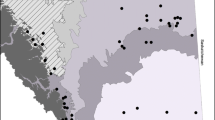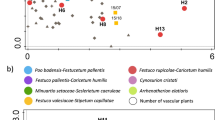Abstract
The Campos grasslands of southern South America have been affected by long-term livestock grazing and increasingly widespread afforestation, but the effects of multiple disturbances have not been well studied, especially at multiple spatiotemporal scales. To determine vegetation response to these disturbances, we constructed grazing exclosures bisecting the forest-grassland ecotone at five sites and measured species richness in nested plots for four treatments (grazed forest, ungrazed forest, grazed grassland, and ungrazed grassland) over 18 months. Species-area curves revealed greater small-scale species richness in grasslands than forests but greater rates of species accumulation in forests and thus little difference in richness between habitats at larger scales. Temporally, small-scale richness differed among sample dates, but rates of species accumulation did not. The interactive effect of habitat and management on total species richness varied with times since the exclosures were built. Grazing and afforestation interactively affect the vegetation of the Campos, as plants respond to changes in both disturbances; over the duration of this study, the removal of grazing decreased species richness in grasslands but increased richness in forests. Our results illustrate that the response of plant species richness to grazing and afforestation varies by the nature of the disturbance mechanism, and that multiple disturbances have complex interactive effects on vegetative responses.




Similar content being viewed by others
References
Altesor A, Di Landro E, May H, Ezcurra E (1998) Long-term species change in a Uruguayan grassland. J Veg Sci 9:173–180
Altesor A, Pezzani F, Grun S, Rodriguez C (1999) Relationship between strategies and morphological attributes in an Uruguayan grassland: a functional approach. J Veg Sci 10:457–462
Baniya CB, Solhoy T, Vetaas OR (2009) Temporal changes in species diversity and composition in abandoned fields in a trans-Himalayan landscape, Nepal. Plant Ecol 201:383–399
Becona G, Astigaraga L, Picasso VD (2014) Greenhouse gas emissions of beef cow-calf grazing systems in Uruguay. Sustain Agric Res 3:89–105
Berretta EJ (2006) Country pasture/forage resources profiles: Uruguay agriculture sector. FAO (Food and Agriculture Organization of the United Nations), Rome
Berretta EJ, Risso DF, Montossi F, Pigurina G (2000) Campos in Uruguay. In: Lemaire G, Hodgson J, de Moraes A, Nabinger C, Carvalho PCF (eds) Grassland ecophysiology and grazing ecology. CABI Publishing, New York, pp 377–394
Bokdam J, Gleichman JM (2000) Effects of grazing by free-ranging cattle on vegetation dynamics in a continental north-west European heathland. J Appl Ecol 37:415–431
Brady NC, Weil RR (2008) The nature and properties of soils, 14th edn. Pearson Prentice Hall, Upper Saddle River
Bremer LL, Farley KA (2010) Does plantation forestry restore biodiversity or create green deserts? A synthesis of the effects of land-use transitions on plant species richness. Biodivers Conserv 19:3893–3915
Buscardo E, Smith GF, Kelly DL, Freitas H, Iremonger S, Mitchell FJG, O’Donoghue S, Mckee AM (2008) The early effects of afforestation on biodiversity of grasslands in Ireland. Biodivers Conserv 17:1057–1072
Cuevas YA, Zalba SM (2010) Recovery of native grasslands after removing invasive pines. Restor Ecol 18:711–719
del Pilar Clavijo M, Nordenstahl M, Gundel PE, Jobbagy EG (2005) Poplar afforestation effects on grassland structure and composition in the flooding pampas. Rangel Ecol Manag 58:474–479
Dickie IA, Yeates GW, St. John MG, Stevenson BA, Scott JT, Rillig MC, Peltzer DA, Orwin KH, Kirschbaum MUF, Hunt JE, Burrows LE, Barbour MM, Aislabie J (2011) Ecosystem service and biodiversity trade-offs in two woody successions. J Appl Ecol 48:926–934
Fahrig L, Coffin DP, Lauenroth WK, Shugart HH (1994) The advantage of long-distance clonal spreading in highly disturbed habitats. Evol Ecol 8:172–187
Foth HD, Schafer JW (1980) Soil geography and land use. Wiley, New York
Fox JF (1979) Intermediate-disturbance hypothesis. Science 204:1344–1345
Geary TF (2001) Afforestation in Uruguay: study of a changing lanscape. J For 99:35–39
Grime JP (1973) Control of species density in herbaceous vegetation. J Environ Manag 1:151–167
Gurevitch J, Scheiner SM, Fox GA (2002) The ecology of plants. Sinauer Associates Inc., Publishers, Sunderland
Hartnett DC, Hickman KR, Walter LEF (1996) Effects of bison grazing, fire, and topography on floristic diversity in tallgrass prairie. J Range Manag 49:413–420
INIA (2011) Agroclimatic bank of INIA stations. http://www.inia.org.uy/online/site/gras.php
Izhaki I, Henig-Sever N, Ne’eman G (2000) Soil seed banks in Mediterranean Aleppo pine forests: the effect of heat, cover, and ash on seedling emergence. J Ecol 88:667–675
Johansen L, Wehn S, Hovstad KA (2016) Clonal growth buffers the effect of grazing management on the population growth rate of a perennial grassland herb. Flora Morphol Distrib Funct Ecol Plants 223:11–18
Kohler F, Gillet F, Gobat JM, Buttler A (2004) Seasonal vegetation changes in mountain pastures due to simulated effects of cattle grazing. J Veg Sci 15:143–150
Landsberg J, James CD, Maconochie J, Nicholls AO, Stol J, Tynan R (2002) Scale-related effects of grazing on native plant communities in an arid rangeland region of South Australia. J Appl Ecol 39:427–444
Lezama F, Baeza S, Altesor A, Cesa A, Chaneton EJ, Paruelo JM (2013) Variation of grazing-induced vegetation changes across a large-scale productivity gradient. J Veg Sci 25:8–21
Li J, Duggin JA, Loneragan WA, Grant CD (2007) Grassland responses to multiple disturbances on the New England Tablelands in NSW, Australia. Plant Ecol 193:39–57
Littell RC, Milliken GA, Stroup WW, Wolfinger RD, Schabenberger O (2006) SAS for mixed models, 2nd edn. SAS Institute Inc., Cary
Loumeto JJ, Huttel C (1997) Understory vegetation in fast-growing tree plantations on savanna soils in Congo. For Ecol Manag 99:65–81
Overbeck GE, Muller SC, Fidelis A, Pfadenhauer J, Pillar VD, Blanco CC, Boldrini II, Both R, Forneck ED (2007) Brazil’s neglected biome: the South American Campos. Perspect Plant Ecol Evol Syst 9:101–116
Pallares OR, Berretta EJ, Maraschin GE (2005) The South American Campos ecosystem. In: Suttie JM, Reynolds SG, Batello C (eds) Grasslands of the world. Food and Agriculture Organization of the United Nations, Rome
Papanastasis V, Koukoura Z, Alifragis D, Makedos I (1995) Effects of thinning, fertilization, and sheep grazing on the understory vegetation of Pinus pinaster plantations. For Ecol Manag 77:181–189
Paruelo JM, Jobbagy EG, Oesterheld M, Golluscio RA, Aguiar MR (2007) The grasslands and steppes of Patagonia and the Rio de la Plata plains. In: Veblen TT, Young KR, Orme AR (eds) The physical geography of South America. Oxford University Press, New York, pp 232–248
Pollock ML, Legg CJ, Holland JP, Theobald CM (2007) Assessment of expert opinion: seasonal sheep preference and plant response to grazing. Rangel Ecol Manag 60:125–135
Ross KA, Taylor JE, Fox MD, Fox BJ (2004) Interaction of multiple disturbances: importance of disturbance interval in the effects of fire on rehabilitating mined areas. Austral Ecol 29:508–529
Rummel RS (1951) Some effects of livestock grazing on ponderosa pine forest and range in central Washington. Ecology 32:594–607
Savadogo P, Tigabu M, Sawadogo L, Oden PC (2009) Examination of multiple disturbances effects on herbaceous vegetation communities in the Sudanian savanna-woodland of West Africa. Flora 204:409–422
Schultz RP (1999) Loblolly—the pine for the twenty-first century. New For 17:71–88
Six LJ, Bakker JD, Bilby RE (2014) Vegetation dynamics in a novel ecosystem: agroforestry effects on grassland vegetation in Uruguay. Ecosphere 5:Art74
Soriano A, Leon RJC, Sala OE, Lavado RS, Deregibus VA, Cauhepe MA, Scaglia OA, Velasquez CA, Lemcoff JH (1991) Rio de la Plata Grasslands. In: Coupland RT (ed) Natural grasslands: introduction and western hemisphere. Elsevier, Amsterdam, pp 367–407
Spiegelberger T, Matthies D, Muller-Scharer H, Schaffer U (2006) Scale-dependent effects of land use on plant species richness of mountain grassland in the European Alps. Ecography 29:541–548
Stanturf JA (2015) Future landscapes: opportunities and challenges. New For 46:615–644
Texeira M, Altesor A (2009) Small-scale spatial dynamics of vegetation in a grazed Uruguayan grassland. Austral Ecol 34:386–394
Tuomisto H, Ruokolainen K, Yli-Halla M (2003) Dispersal, environment, and floristic variation of western Amazonian forests. Science 299:241–244
Uruguay XXI: Investment and Export Promotion Agency (2010) Forestry industry: investment opportunities in Uruguay. Republica Oriental del Uruguay, Montevideo
Valone TJ (2003) Examination of interaction effects of multiple disturbances on an arid plant community. Southwest Nat 48:481–490
Wayman RB, North M (2007) Initial response of a mixed-conifer understory plant community to burning and thinning restoration treatments. For Ecol Manag 239:32–44
Zuloaga FO, Morrone O, Belgrano MJ (eds) (2008) Catalogo de las Plantas Vasculares del Cono Sur. Missouri Botanical Garden press, St. Louis
Acknowledgments
We thank C. Adams and S. Batiuk for assistance with field sampling; J. Evanchenko, L. Ingaramo, and J.P. Posse for assistance with exclosure establishment and maintenance; S.D. Duke for statistical guidance; M. Bemhaja, M. Juarena, and especially E. Marchesi provided valuable contributions to species identifications and our understanding of grasslands in Uruguay. M. Bemhaja, R.L. Edmonds, and J.J. Tewksbury provided valuable feedback on earlier versions of this manuscript. Funding was provided by Weyerhaeuser Global Timberlands Technology.
Author information
Authors and Affiliations
Corresponding author
Rights and permissions
About this article
Cite this article
Six, L.J., Bakker, J.D. & Bilby, R.E. The combined effects of afforestation and grazing on Uruguayan grassland vegetation at multiple spatiotemporal scales. New Forests 47, 685–699 (2016). https://doi.org/10.1007/s11056-016-9538-4
Received:
Accepted:
Published:
Issue Date:
DOI: https://doi.org/10.1007/s11056-016-9538-4




